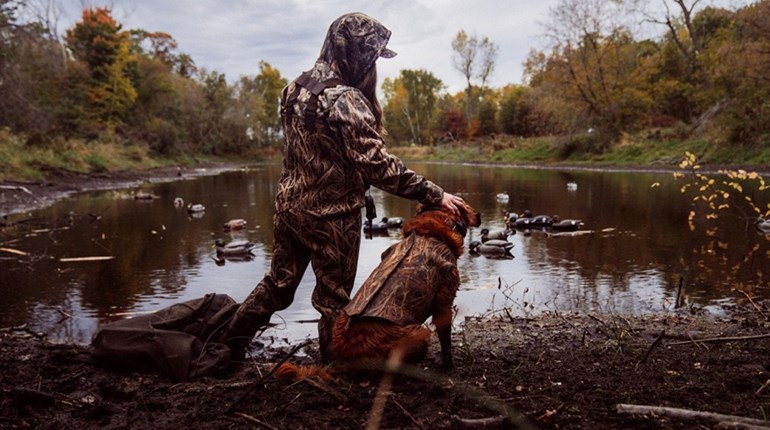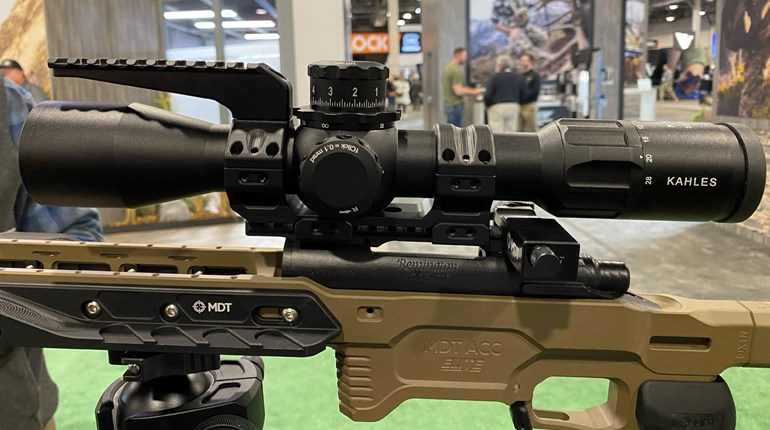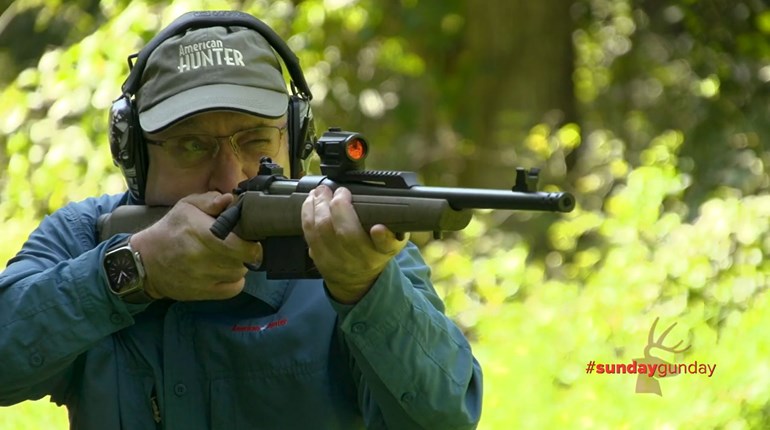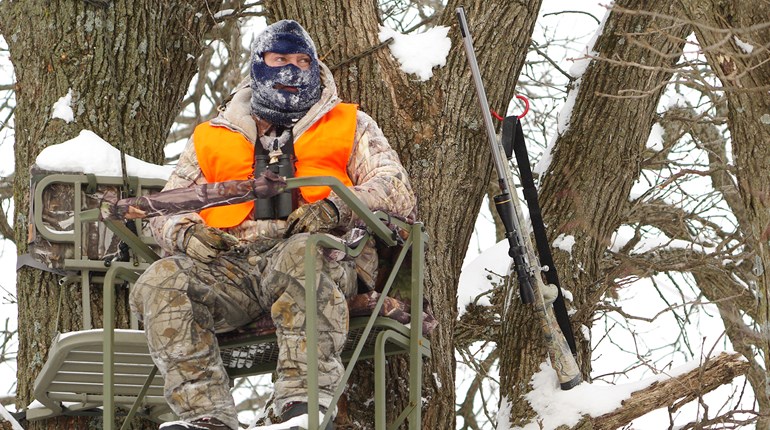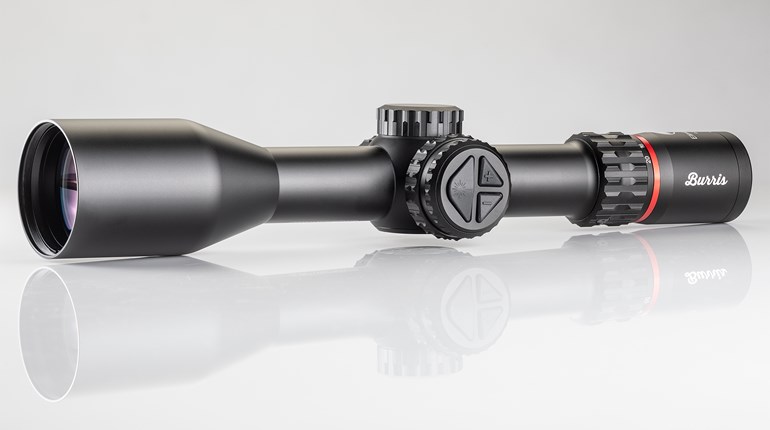
Our position atop a butte presents the Sonoran Desert, piece by inviting piece, from the curtain of crepuscular light. Lavender twilight turns to magenta; magenta to amber; amber to yellow morning light until all around is a stupendous 360-degree view of red earth, sharp draws, open desert and mazes of chollas, barrel cactus, mesquite, junipers and yellow grass moving gently on morning thermals. We shift positions around the butte some 300 feet over the desert floor and glass with 15X binoculars mounted atop tripods.
Three hours after sunrise, with not a deer sighted, Francisco “Poncho” Guerrero whispers, “Grande, muy grande.”

I take my eyes out of my own glass as he takes his binocular off his tripod and puts on his spotting scope. I follow his scope and see that he’s looking to the edges of possibility, some 2,000 yards away. Out there somewhere in the sea of cactus, short trees and majestic red buttes is a buck, a muy grande mule deer buck.
After four days in this rifleman’s country I have come to understand that Poncho isn’t easily impressed by inches of antler. He has been guiding hunters in this desert for 35 years. R&K Hunting Co. (801-369-7272; facebook.com/mxhuntingcompany) and its Mexican affiliate, MX Hunting Co., are staffed with seasoned guides, but even among them, Poncho is a veteran. I’d only heard him say “grande” once before, during the waning twilight of day one when he’d spotted a 30-inch buck at another obscene distance.
I calmly rise from my pop-up chair. The stillness of this open country engenders a meditative mood even a muy grande buck doesn’t shatter. Poncho leans aside so I can peer into his spotting scope. Just then the buck swaggers out from behind chollas with the morning sun on its dark antlers as if a spotlight had been turned on to highlight his dramatic entrance into the story.
Yes, certainly muy grande.
I mark the location and pull away with something else running through my mind: the shot.
Back East, when you spot a buck you want, you put the crosshair on its vitals and kill the deer. Different story out here. Out in this big country you are probably going to have to get a lot closer first. I look at my rifle, a Savage chambered in 7mm Rem. Mag. It’s a rifle that shoots, as Savages do. It is topped with a Vortex 5X-20X-50mm riflescope. I am comfortable with this rig in a hunting situation to 600 yards—provided I can get solid on a bipod or sticks. I know the bullet drop and how to use the MOA system with this scope/caliber combination. The wind this morning is light, hard to even feel.
I settle back into my pop-up stool and try to find the buck in my binocular. We won’t move until the buck beds. We will then plan and execute a stalk.
With time to think, the shot, oh boy the shot, keeps playing out in my head and I am thankful this hunt actually began the summer before in Wyoming.
The Long-Range School for Hunters
I joined a dozen other hunters for a two-day long-range school in Wyoming put together by Outdoor Solutions. The evening before the first day we gathered on a porch at a lodge in the postcard-gorgeous foothills outside Evanston. Mule deer were coming out to feed on the slopes above us. Some were bucks. Their velvet seemed to glow in the red waning light.
“Okay, let’s hear about each of your goals here,” said Erik Lund, Outdoor Solutions’ lead instructor. “What is the longest shot each of you has taken while hunting—and did you make it?”
Erik is a grizzly bear of a man with a lot of law-enforcement experience. He is just evasive enough about what he does in law enforcement to add an air of mystery to his booming persona. We didn’t know then that in two days all of us would drop into a shooting position and "kill" an 18-inch steel target at 600 yards in less than 3 seconds. That was in a fun competition at the end of the two-day school, and after 1,000-yard targets made the 600-yard target feel like a chip shot.

We all gave Erik a snapshot of our rifle shooting experience. He then had us download an app. There are a few good apps for hunters who want to shoot longer. The instructors at Outdoor Solutions like BallisticsARC. There is a free version available. Plug in your rifle load data and more and it gives precise calculations out to extreme long range so you’ll know where your bullet will impact based on known variables you input.
The app also uses aerial photos. These allow you to pinpoint your current location via a GPS tool and then to mark where your target is actively on a smartphone’s screen. It then gives the distance and calculations for bullet drop. None of us thought this tool would be very useful for hunting; after all, unless you see a bedded buck you want to take, game rarely stays around long enough for us to play with apps on our smartphones. But it is a great teaching tool, as it helps you read distance and calculate your bullet’s performance in real time.
We loaded data for 6.5 Creedmoor factory-loaded ammo from Hornady, as this is what we would be shooting from Weatherby’s off-the-shelf Vanguard rifles. Hunters may bring their own rifles, but the school encourages hunters to use its rifles topped with Zeiss optics so they may get the most out of the instruction.
The next day on a range we learned to work in teams including a spotter and a shooter, as we shot from 400-1,000 yards off benches. We learned to call wind drift at various ranges by using the MOA system. Basically, 1 MOA (minute of angle) is 1 inch at 100 yards (actually, the precise measurement is 1.047 inches), 2 inches at 200 yards and so on.
We’d dial in the range with a ballistic reticle on our scopes to adjust for bullet drop then hold into the wind a certain number of hash marks (basically equivalent to MOAs) to compensate for the wind drift we estimated. When we hit steel targets, our spotters called hits. They tried to call misses, too. We kept pushing farther downrange until we all consistently hit a 1,000-yard target in a 10-mph crosswind.
We soon learned there are too many variables to ethically shoot game at 1,000 yards. Some riflemen will disagree with that declaration; certainly, an experienced long-range shooter in optimal and known conditions can kill big game at 1,000 yards and beyond. For a hunter in the field in perhaps steep terrain he must compensate for, in changing weather, the conditions are rarely completely known and optimal for such long shots on game.
We learned this more precisely on day two when we went out onto a ranch and took positions we might while hunting and engaged steel targets from 600-1,000 yards. Storms blew in, it rained, the wind shifted, the sun came out and went away, and all along we kept moving and shooting as we read the conditions. By the end of day two all of us could quickly "kill" a target at 600 yards in 3 seconds or less. Most of us agreed our maximum distance to ethically shoot game would be 700 yards, but while hunting it would be 600 yards or less, perhaps a lot less.
Back in the Field
In the Sonoran Desert, we wait and watch as the buck pops into openings between vegetation we can see into from that tall butte. When we finally lose sight of the mule deer at about 11 a.m., we know the buck likely bedded. We leave a spotter back on the butte to let us know if we bump the buck and start the stalk.
We have a long way to go across red ground and through cactus and trees standing 10-15 feet tall. The best markers are a few distinct barrel cactus. We move to them. When we get to them we’ll turn left, knowing the buck will then be close.
As we move in I know this isn’t going to be the long shot I prepared for. If it happens, it is going to be close. I dial down the scope to 5X. I wrap the rifle sling around my left arm and place my right thumb on the rifle’s safety. Somewhere ahead the big mule deer buck is bedded. This shot, if it happens, is going to be fast.
We reach the barrel cactus, take some deep breaths, turn left and creep forward. Each step is carefully placed on the balls of our feet. We are looking for a piece of antler, a moving ear in the shade of a mesquite tree. We are lucky there are no other deer with or near this buck.
Then, too soon, the buck leaps up—50 yards closer than we expect. Its antlers seem to appear out of the brush and shade and to soar into the light and away. I run 20 yards right and stop. The buck has to run through an opening about 50 yards long and 15 yards wide. He doesn’t. He stops for a moment with his head up and most of his chest and body hidden in dense brush.
I barely stop before I shoot so fast Poncho is surprised. This isn’t the shot I trained for in Wyoming. This is a shot I trained for all my life hunting squirrels, rabbits and deer in the East.
“Te perdiste?” asks Poncho, so excited he forgets to speak English.
“No, it’s a good hit,” I say as I touch Poncho’s chest.
The buck didn’t go 50 yards. We see its antlers first. With a 27-inch inside spread, this buck is hardly the biggest they’ve killed, but it was exactly what we were after, and what I dreamt of.

The next day we go out for Coues deer, that little whitetail subspecies that lives in these deserts. After many hours glassing and a long stalk, this shot is different. I pass on a shot at 500 yards, as there isn’t time to get stable as the buck walks across a steep, brushy slope. An hour later we slip to 250 yards but can only see a 2-inch patch of the buck as it lays deep in the shade of junipers. The Wyoming school comes in handy. I take my time and go partially prone on a rocky, cactus-cluttered hillside. I use my pack as a rest for the rifle and place a fleece under my right elbow and settle in and press the shot. The heavy, 8-point Coues deer buck never gets out of its bed.
I leave pleased I prepared for longer shots and that I came to know my limitations even better. Competence with a hunter’s tools, after all, is the yard stick by which we measure ourselves as sportsmen.
■ ■ ■
1. Your rifle is steady without you. Unless there is a spectacularly hard wind, your rifle is steady when you rest it on the ground. The shakes you see on the crosshairs are mostly from you.
2. Move your thumb. Lund advises riflemen to avoid crossing their strong-side thumb (right thumb for right-handed shooters) over the firearm. Instead, let it rest above the trigger guard. This will help prevent you from over-gripping the rifle and causing shake.
3. Push in to your tripod or sticks. When you get settled, either when prone, kneeling or standing, push slightly forward to “load” your bipod or shooting sticks. This will help settle the rifle.
4. Carry a bean bag. Carry something in your pack, a spare fleece or other item, you can use to help you get into a comfortable and stable position.
5. Train with a .22. If you can’t get to a range that’ll allow you to shoot long, consider practicing with a .22 rifle set up just like your big-game rifle. You’ll still need some range time at 300-plus yards with your big-game gun, but the .22 practice sessions will help.
6. Learn to read a heat mirage. When heat waves are straight up and down the wind has no value; at 11 and one o’clock the wind is 0-3 mph; at 10 and two it is 3-5; at 45 degrees it is 5-8 mph; and at 55 degrees it is 8-12 mph.
7. Maintain a good follow-through. Press and hold the trigger to the rear as the rifle recoils. Don’t pick up your head. Try to spot your own impact through the scope. Once the rifle has settled, work the bolt while keeping your head on the rifle.
For more information, click here.















